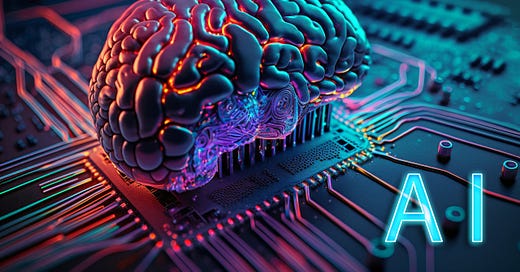Welcome to the third issue of the Infinitary Connections, the official Substack of the Infinitary Fund. This is a weekly newsletter where Nic and I will be sharing some of our insights across the world of finance, economics, technology, and more. As partners in the Infinitary Fund, we have a unique perspective on the world, the markets, and the shape of things to come.
This week we discuss the difference between hard AI and soft AI. If you aren’t subscribed, you can subscribe for free below.
And make sure to like this post so we know if it resonated.
Let’s dive in.
AI EVERYWHERE
Artificial Intelligence (AI) has emerged as a transformative field, encompassing various approaches and methodologies. It seems to be everywhere these days. In a short amount of time AI has gone from science fiction to science fact and if you want to prosper in this world, you will need to give yourself an edge and understand the applications and possibilities of AI.
Within artificial intelligence are two distinct and significant branches, hard AI and soft AI. While they both share the goal of simulating actual human intelligence, they differ significantly in regard to their approaches, applications, and principles. We are going to explain this further in this issue.
HARD AI
Hard AI is also known as strong AI or artificial general intelligence (AGI). This refers to artificial intelligence systems that possess deep human-level intelligence and can understand, reason, learn, and perform tasks across a variety of verticals. With Hard AI, the goal is to perfectly replicate the complete abilities of cognitive capabilities and consciousness observed in humans. Hard AI aims to create machines that possess self-awareness and consciousness, enabling them to engage in complex decision-making and exhibit creativity.
What could go wrong?
Breaking it down further, here are some of the key features and characteristics of hard AI.
General Intelligence: Hard AI systems are designed to have a broad spectrum of intellectual abilities. This is to ensure that it is similar to humans in order for hard AI to handle and complete a wide variety of tasks.
Self-awareness and Consciousness: Hard AI aspires to replicate human consciousness, self-awareness, and introspection. The objective is to create machines that possess subjective experiences and a sense of self which is a bit frightening.
Context Independence: Hard AI is context-independent, meaning it can apply knowledge from one domain to another, adapt to new situations, and learn new concepts without extensive reprogramming.
Cognitive Reasoning: Hard AI emphasizes the ability to engage in high-level cognitive reasoning, understanding complex concepts, and employing logical thinking to solve problems.
Autonomy: Hard AI aims to create autonomous systems capable of acting independently, exhibiting decision-making skills, and even surpassing human capabilities in certain areas. Again, just a bit frightening.
WHAT DOES IT MEAN?
With the focus on replicating human-level intelligence, it is believed that hard AI holds the potential for groundbreaking advancements in robotics, natural language understanding, medical diagnosis, and scientific research. It still raises ethical and philosophical questions regarding the nature of consciousness, machine rights, and the impact on human employment and society in general.
Now that we have made you wonder about the possibility of a real life Skynet, let’s go into soft AI.
SOFT AI
Soft AI, also referred to as weak AI or narrow AI, focuses on developing AI systems that are specialized and task-specific. These systems excel in specific domains or perform well-defined functions but lack the overall cognitive capabilities and general intelligence of hard AI. Soft AI systems are built to solve particular problems efficiently, often outperforming humans in those specific tasks.
They are also a lot less ethically frightening.
Let’s break it down.
Task-Specific Focus: Soft AI is designed to excel in specific domains or perform particular functions. These systems are optimized for a well-defined set of tasks and lack the versatility of hard AI.
Limited Contextual Adaptation: Soft AI is highly dependent on the context in which it was trained or programmed. These systems usually struggle to transfer knowledge or adapt to new situations outside their designated area of expertise.
Narrow Expertise: Soft AI is highly specialized and exhibits expertise in specific areas, such as natural language processing, image recognition, or autonomous driving. These systems are typically designed to excel within a confined domain.
Lack of Consciousness: Unlike hard AI, soft AI does not possess consciousness or self-awareness. These systems operate solely based on predefined algorithms and patterns, without subjective experiences or introspection.
Reliance on Human Intervention: Soft AI often requires human supervision and intervention, particularly in complex and uncertain scenarios. These systems lack the autonomy and decision-making capabilities of hard AI.
WHAT DOES IT MEAN?
Soft AI has witnessed significant advancements and widespread adoption as it makes life easier and doesn’t pose a threat of overthrowing the status quo and becoming our new machine overlord. Soft AI powers virtual assistants, recommendation systems, fraud detection algorithms, and autonomous vehicles. This contributes to increased productivity, improved customer experiences, and enhanced decision-making. Yet there are still concerns in regard to job displacement, data privacy, and biases in algorithms.
Now that you know the differences, we hope that you can be better prepared for understanding artificial intelligence and more importantly, how you can use it to your advantage.
BEFORE YOU GO
If this helps, please share it. I can promise you that someone in your network needs to read this.
We will see you next week. Thanks for being here.
Mike and Nic.






Consciousness is not a requirement of hard AI. It could well be simply a zombie. Indeed, consciousness may need a biological substrate. https://everythingrum.blogspot.com/2019/09/interlude-unconscious-artificial.html?m=1